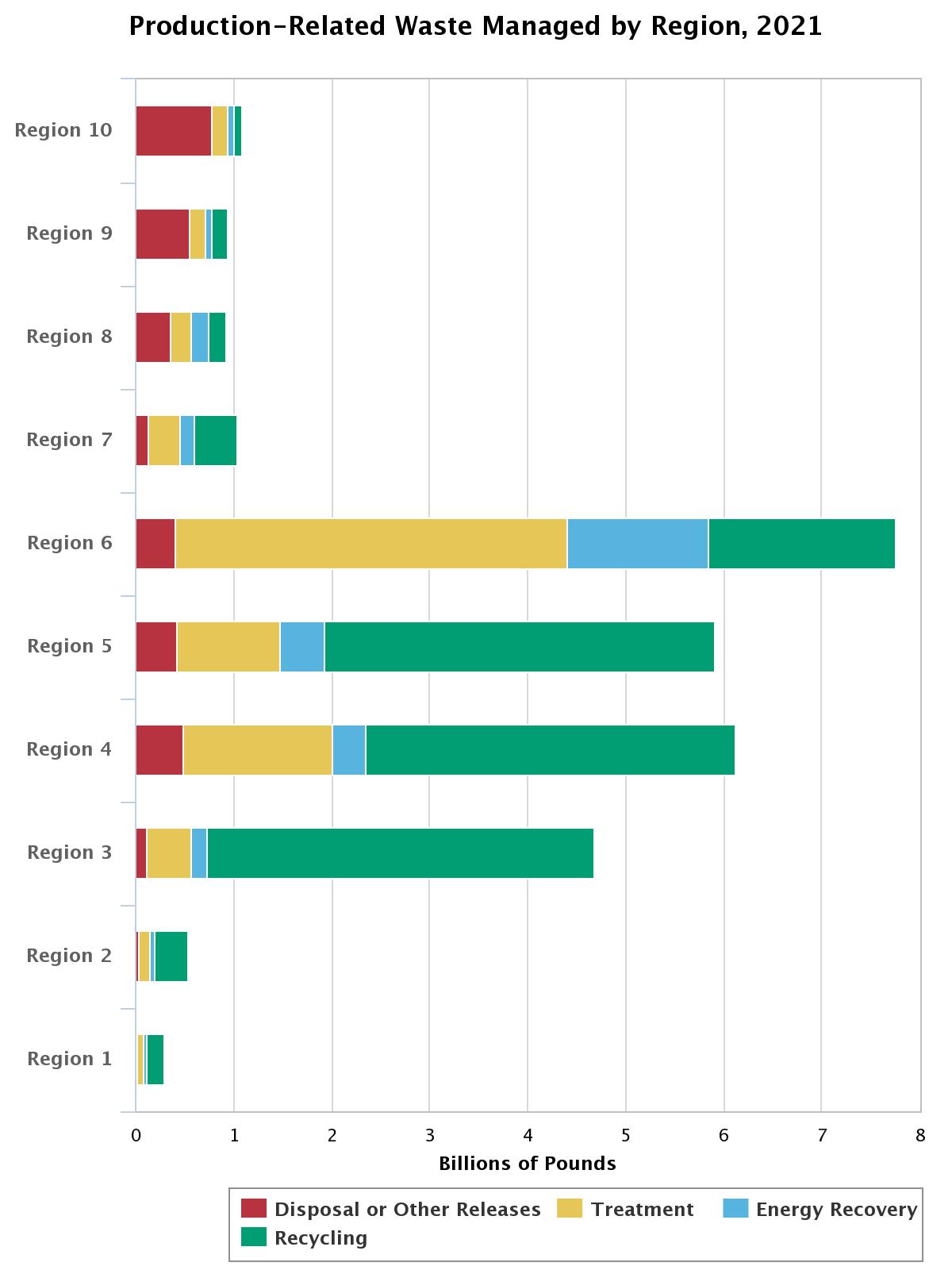The U.S. Environmental Protection Agency (USEPA) released its 2021 Toxics Release Inventory (TRI) National Analysis, which shows that environmental releases of TRI chemicals from facilities across the nation are declining. Releases in 2021 were 10% lower than 2012 releases, even with an 8% increase from 2020 to 2021. Nationwide, facilities managed more than 89% of their TRI chemical waste through preferred practices such as recycling, energy recovery, and treatment, while reporting that they released 11% of their TRI chemical waste into the environment.
The report reveals that USEPA Region 8, which includes Colorado, Montana, North Dakota, South Dakota, Utah, and Wyoming as well as 28 Tribal Nations, saw a long-term decline in production related waste. In 2021, facilities in USEPA Region 8 reported managing 919 million pounds of production related waste and releasing 349 million pounds of TRI chemicals into the environment.
The report also shows a long-term decline in Region 5, which includes Illinois, Indiana, Michigan, Minnesota, Ohio, Wisconsin and 35 Tribal Nations. In 2021, about 93% of TRI chemical waste from facilities in Region 5 was managed through preferable techniques such as recycling, combustion for energy recovery, and treatment, while only 7% was released into the environment.
For the second time, the TRI National Analysis reported on 176 perfluoroalkyl substances (PFAS). Facilities reported managing 1.3 million pounds of these chemicals as waste. This is an increase from the 800,000 pounds in 2020 and is largely due to reporting on one PFAS, perfluorooctyl iodide, which USEPA began requiring facilities to report in 2021. Most of the facilities that manage PFAS operate in the chemical manufacturing and hazardous waste management sectors. The hazardous waste management sector accounted for roughly 80% of the 108,334 pounds of PFAS released into the environment, primarily to regulated landfills.
Features of the 2021 TRI National Analysis includes updated visualizations and analytical tools to make data more useful and accessible to communities, including the option to view data by region and watershed. USEPA has also updated demographic information in the “Where You Live” mapping tool and in the Chemical Profiles section. Readers can view facility locations with overlayed demographic data to identify potential exposure to TRI chemical releases in vulnerable communities. Community groups, policymakers, and other stakeholders can use this data, along with other environmental data, to better understand which communities may experience a disproportionate pollution burden and act at the local level.
To view local data and analysis, visit 2021 TRI National Analysis
Decline in Region 5 & 8 Toxic Release Inventory Chemicals
The U.S. Environmental Protection Agency (USEPA) released its 2021 Toxics Release Inventory (TRI) National Analysis, which shows that environmental releases of TRI chemicals from facilities across the nation are declining. Releases in 2021 were 10% lower than 2012 releases, even with an 8% increase from 2020 to 2021. Nationwide, facilities managed more than 89% of their TRI chemical waste through preferred practices such as recycling, energy recovery, and treatment, while reporting that they released 11% of their TRI chemical waste into the environment.
The report reveals that USEPA Region 8, which includes Colorado, Montana, North Dakota, South Dakota, Utah, and Wyoming as well as 28 Tribal Nations, saw a long-term decline in production related waste. In 2021, facilities in USEPA Region 8 reported managing 919 million pounds of production related waste and releasing 349 million pounds of TRI chemicals into the environment.
The report also shows a long-term decline in Region 5, which includes Illinois, Indiana, Michigan, Minnesota, Ohio, Wisconsin and 35 Tribal Nations. In 2021, about 93% of TRI chemical waste from facilities in Region 5 was managed through preferable techniques such as recycling, combustion for energy recovery, and treatment, while only 7% was released into the environment.
For the second time, the TRI National Analysis reported on 176 perfluoroalkyl substances (PFAS). Facilities reported managing 1.3 million pounds of these chemicals as waste. This is an increase from the 800,000 pounds in 2020 and is largely due to reporting on one PFAS, perfluorooctyl iodide, which USEPA began requiring facilities to report in 2021. Most of the facilities that manage PFAS operate in the chemical manufacturing and hazardous waste management sectors. The hazardous waste management sector accounted for roughly 80% of the 108,334 pounds of PFAS released into the environment, primarily to regulated landfills.
Features of the 2021 TRI National Analysis includes updated visualizations and analytical tools to make data more useful and accessible to communities, including the option to view data by region and watershed. USEPA has also updated demographic information in the “Where You Live” mapping tool and in the Chemical Profiles section. Readers can view facility locations with overlayed demographic data to identify potential exposure to TRI chemical releases in vulnerable communities. Community groups, policymakers, and other stakeholders can use this data, along with other environmental data, to better understand which communities may experience a disproportionate pollution burden and act at the local level.
To view local data and analysis, visit 2021 TRI National Analysis

